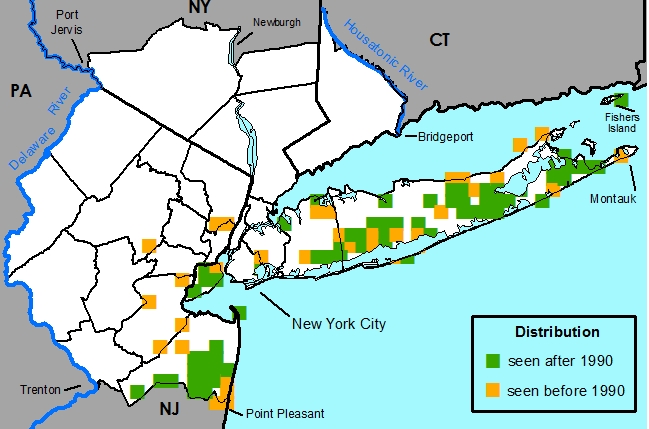Ilex glabra (L.) Gray - Inkberry,Gallberry,Indian Tea,Winterberry Tea,Evergreen Winterberry
Common Names
Inkberry,Gallberry,Indian Tea,Winterberry Tea,Evergreen WinterberryField Identification
Upright evergreen shrub 1-2 m tall with alternate, simple leaves with mostly entire margins except for a few small teeth at the apex, and black berries on female specimens.Food uses
Disclaimer: The information provided here is for reference and historical use. We do not recommend nor do we condone the use of this species for food purposes without first consulting a physician.This species is a good source of light clear honey.
Medicinal uses
Disclaimer: The information provided here is for reference and historical use. We do not recommend nor do we condone the use of this species for medicinal purposes without first consulting a physician.Other uses
(Galle, 1997)Used for ornamental plantings with many cultivars selected.
Poisonous properties
Disclaimer: The information provided here is for reference and historical use. If you believe you have been poisoned, please contact the Poison Control Office near you (look for the number in the front of the phone book).
Ilex fruit and leaves contain an array of potential toxins that can cause moderate to severe nausea, vomiting, diarrhea, and rarely narcosis. Death is unlikely.
Nomenclature
Ilex glabra (L.) Gray, Manual ed. 2, 264. 1856.
Prinos glaber L., Sp. Pl. 330. 1753, exclud. syn.
Winterlia triflora Moench, Methodus 74. 1794, p. p.
Ilex angustifolia var. ligustrifolia DC, Prodr. 2: 14. 1825, p. p.
Ennepta myricoides Raf., Sylva Tellur. 52. 1838.
Winterlia glabra Moench ex K.Koch, Hort. Dendrol. 211. 1853.
TYPE: unknown
Ilex glabra f. leucocarpa F. W. Woods, Rhodora 58: 25. 1956.
TYPE: USA, Florida, Jackson County, 4 miles south of Marianna, 20 January, 1955: F. W. Woods C.E.F. 2 (Holotype: US; Isotype: NY)
Ilex glabra var. austrina Ashe, J. Elisha Mitchell Sci, Soc. 40: 44. 1924.
TYPE: USA, Georgia? (Holotype: ?)
Description
HABIT Perennial, evergreen, phanerophytic, shrub, diclinous and dioecious, 1-3 m tall, often stoloniferous.
STEMS Main stems erect, brown or dark gray, round. Bark smooth, not exfoliating. Branches erect or ascending. Twigs brown or dark gray, not odoriferous, terete, 2-4 mm in diam., glabrous or with short and unbranched erect hairs, sparse, distributed apically, eglandular. Pith white, round, nodal diaphragm absent. Sap translucent.
BUDS Terminal and axillary, scattered along stem; axillary buds 1 per axil. Leaf scars crescent-shaped; bundle-traces 1.
LEAVES Alternate, simple, spiral, 1 per node, crowded toward stem apex or spaced somewhat evenly along stem, divergent from stem. Stipules present, lateral, deciduous, scale-like, minute, caduceus, dropping shortly after buds open. Leaves petiolate, petiole terete, 0.3-0.8 cm long, glabrous or with short and unbranched erect hairs, sparse or moderately dense, distributed throughout. Not glabrescent, eglandular. Leaf blades: abaxial surface light yellowish green, adaxial surface green or dark green, elliptic or obovate, bilaterally symmetric, 2-5 cm long, 1-2 cm wide, coriaceous, base acute or cuneate, margin crenate, sparsely toothed toward apex, apex obtuse, mucronulate, abaxial surface glabrous, eglandular. Adaxial surface glabrous, eglandular.
INFLORESCENCES Unisexual, axillary, solitary or compound.
FEMALE FLOWERS Formed on the current season's growth, with sepals and petals readily distinguishable from one another, 5-8merous, 1 flower per inflorescence, fragrance absent. Calyx actinomorphic, persistent on fruit. Sepals 5-8. Corolla, actinomorphic, deciduous, white. Petals 5-8, apex obtuse, abaxial surface glabrous, adaxial surface glabrous, eglandular. Gynoecium syncarpous. Style and stigma 1, stigma capitate. Ovary superior, glabrous. Placentation axile. Androecium abortive, rudimentary and sterile.
MALE FLOWERS Male inflorescence axillary compound cyme. Peduncle 0.3-0.5 cm long. Pedicels 2-4 mm long, glabrous or with short and unbranched hairs, eglandular. Perianth of two whorls. Calyx actinomorphic, persistent. Sepals 5-8, triangular, 1 mm long, margin entire or ciliate, apex obtuse, glabrous, eglandular. Corolla actinomorphic, of free petals, deciduous, abaxial and adaxial surfaces white. Petals 5-8, margin entire, apex acute or obtuse, glabrous, eglandular. Stamens 5-8. Anthers opening along the long axis, yellow. Filaments free, glabrous, eglandular. Gynoecium vestigial.
FRUITS Drupe, black, globose, 6-10 mm long, 6-10 mm wide, glabrous, eglandular; white fruited (f. leucocarpa) and red fruited specimens reported.
SEEDS 5-8, thin, laterally compressed; oblong elliptic in cross section, 3.5-4 mm long, 2.4 mm wide, glabrous, eglandular.
Habitat
Bogs, swamps, pond shores, wet woods, usually in acidic substrate; often in sandy soils. This species has a high degree of salt tolerance. Eberwine, 1979Distribution
Native to eastern coastal North America.
United States -- AL, AR, CT, DE, FL, GA, LA, MA, MD, ME, MS, NC, NY, NJ, NH, RI, SC, TX, VA
Canada -- NS
New York Metropolitan Region -- Native, found mostly along the coastal plain of the metropolitan area.
Rarity Status
Heritage Global Rank -- G5
Connecticut -- S2
New Jersey -- Not listed
New York -- Not listed
Species Biology
Flowering
June [week 2] - July [week 3]
Pollination
Probably Mellittophily
Fruiting
July [week 4] - often persisting until the following Spring
Dispersal
Endozoochory -- Avian frugivores: Cardinalis cardinalis (Cardinal), Sialia sialis (American Bluebird), Sphyrapicus varius (Yellow-bellied Sapsucker)
Germination
Schopmeyer, 1974; Dirr, 1991; Dirr, 1987
In nature, holly seeds usually germinate from 1-3 years after dispersal, and natural regeneration commonly is sparse. The seeds have hard seed coats and dormant or immature embryos; as a rule they are difficult to germinate. Germination is probably epigeous. One study showed that 8 months of warm stratification produced a germination rate of 57%.

